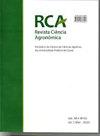大豆作物线虫的无人机检测
IF 1
4区 农林科学
Q3 AGRICULTURE, MULTIDISCIPLINARY
引用次数: 0
摘要
-全球油籽消费量在过去5个生长季节一直在逐步增长,其中大豆占该部门的60%。因此,为了解决Goiás州里约热内卢Verde地区的植物病理学问题,本研究旨在通过线性回归确定R3期大豆中H. glycines和P. brachyurus检测的最佳光谱范围,并通过多元线性回归建立数学模型。为此,在实验区取样土壤和根系,并使用Sentera传感器进行飞行。数据用于阐述回归和验证2个数学模型。在简单的线性回归中,仅在可见范围内,对于不活的囊肿,在绿色、红色和568 nm波段具有良好的R²值。当使用逐步统计时,发现H. glycines的结果更好,现在的R²(aj)为0.7430,然后检测到P. brachyurus。通过对非活包囊进行多元线性回归,得到R²(aj) = 0.7430的数学模型,可以检测线虫在大豆田间的空间分布,从而进行本地化管理,优化应用。用简单线性回归得到的数学模型也可以得到很好的结果。本文章由计算机程序翻译,如有差异,请以英文原文为准。
Detection of nematodes in soybean crop by drone
- Global consumption of oilseeds has been growing progressively in the last fi ve growing seasons, in which soybean represents 60% of this sector. Thus, in order to maintain a high production in the region of Rio Verde, State of Goiás, against the phytopathological problems, this study aimed to de fi ne the best spectral range for the detection of H. glycines and P. brachyurus by linear regressions in soybean at R3 stage, as well as the elaboration of mathematical models through multiple linear regressions. For this, soil and root were sampled in the experimental area, as well as a fl ight was performed with the Sentera sensor. Data were used for the elaboration of regressions and for the validation of 2 mathematical models. Signi fi cant values were observed in simple linear regression only for cysts, in the visible range, with a good R² value for the Green, Red and 568 nm bands, to nonviable cysts. When working with the stepwise statistics, better results are found for H. glycines , which now has an R²(aj) of 0.7430 and P. brachyurus is then detected. From the mathematical model obtained with the multiple linear regression for non-viable cysts with an R²(aj) of 0.7430, it is possible to detect the spatial distribution of nematodes across the soybean fi eld, in order to perform a localized management, optimizing the applications. Good results are also possible using the mathematical model obtained by simple linear regression.
求助全文
通过发布文献求助,成功后即可免费获取论文全文。
去求助
来源期刊

Revista Ciencia Agronomica
Agricultural and Biological Sciences-Horticulture
CiteScore
2.00
自引率
0.00%
发文量
41
审稿时长
4-8 weeks
期刊介绍:
To publish technical-scientific articles and study cases (original projects) that are not submitted to other journals, involving new researches and technologies in fields related to Agrarian Sciences. Articles concerning routine analysis, preliminary studies, technical notes and those which merely report laboratorial analysis employing traditional methodology will not be accepted for publication. The Journal of Agronomical Science also has the mission to promote the exchange of experience in the referred fields.
 求助内容:
求助内容: 应助结果提醒方式:
应助结果提醒方式:


